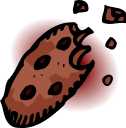Reading Left to Right!!! No Reason
English
doesn't have to be read or written from left to right. It
just is.
Many
other languages, among them Chinese, Arabic, and Hebrew, are
written right to left or even bottom to top. Why, then, is
English left to right?
Well,
the best explanation is that the ancient Greeks said
so.
 Seriously,
the scholars of ancient Greece experimented with the various
methods of putting words on tablets and such and then
reading those words. The Greeks decided that going from left
to right was the easiest thing to do, the one that made the
most sense. So that's what they did. And when the Romans
conquered the Greeks, they kept this practice, applying it
to Latin.
Seriously,
the scholars of ancient Greece experimented with the various
methods of putting words on tablets and such and then
reading those words. The Greeks decided that going from left
to right was the easiest thing to do, the one that made the
most sense. So that's what they did. And when the Romans
conquered the Greeks, they kept this practice, applying it
to Latin.
Most
Western languages have their roots in Greek and Latin, so
that's why most of those Western languages have words and
sentences that progress from left to right.
Galileo
Galilei, the famous Italian scientist who discovered
Jupiter's four closest moons, did not invent the telescope
that he used to see those moons. In fact, he just made the
telescope better.
Hans
Lippershey, a man from the Netherlands who made eyeglasses,
invented the telescope in 1608. He wanted to see things far
away--on land--so he put existing technology and his
imagination together and came up with the telescope.
The
Dutch government tried to keep the invention a secret, but
it didn't work out  that
way. Galileo heard about it and built his own. Galileo's
telescope was three times more powerful than Lippershey's,
and Galileo had the idea to turn it into the night sky. And
in 1611, he saw Ganymede, Io, Europe, and Callisto--proof
that Jupiter had moons and that Earth wasn't the center of
the universe (or even the solar system).
that
way. Galileo heard about it and built his own. Galileo's
telescope was three times more powerful than Lippershey's,
and Galileo had the idea to turn it into the night sky. And
in 1611, he saw Ganymede, Io, Europe, and Callisto--proof
that Jupiter had moons and that Earth wasn't the center of
the universe (or even the solar system).
 that
way. Galileo heard about it and built his own. Galileo's
telescope was three times more powerful than Lippershey's,
and Galileo had the idea to turn it into the night sky. And
in 1611, he saw Ganymede, Io, Europe, and Callisto--proof
that Jupiter had moons and that Earth wasn't the center of
the universe (or even the solar system).
that
way. Galileo heard about it and built his own. Galileo's
telescope was three times more powerful than Lippershey's,
and Galileo had the idea to turn it into the night sky. And
in 1611, he saw Ganymede, Io, Europe, and Callisto--proof
that Jupiter had moons and that Earth wasn't the center of
the universe (or even the solar system).
Galileo
is often thought to have invented the telescope because he
made so many important discoveries with it. Galilei invented
many other things, including the microscope but the credit
for inventing the telescope goes to Holland's Hans
Lippershey.
 Speaking
of parchment, we get the word paper from
papyrus, the plant that gave us the pulp on which
ancient peoples wrote.
Speaking
of parchment, we get the word paper from
papyrus, the plant that gave us the pulp on which
ancient peoples wrote.
Today,
we write much of time using pencils. The word pencil
comes from Latin as well. This word is penicillum,
which meant "little tail." Writers of old used tiny brushes,
which looked like little tails.
Bette
Graham was 17 when she got a job at a Texas bank as a
secretary, even though she didn't know how to type. She was
young and energetic, and she worked. The company she worked
for sent her to secretary school, and she was typing in no
time at all.
The
1950s had seen the widespread of the electric typewriter,
which typed faster but also allowed for more mistakes. Also,
the ribbon in the electric typewriter made it harder to
erase mistakes than the ribbons in the manual
typewriters.
One
holiday season, Bette Graham was a bank window and, in a
flash of brilliance, decided to create a paint to cover up
typewriting mistakes.
 It worked!
In 1956, she sold her first bottles of her new product,
which she called "Mistake Out." She made it in her kitchen,
and her son Michael and his friends bottled it in the family
garage.
It worked!
In 1956, she sold her first bottles of her new product,
which she called "Mistake Out." She made it in her kitchen,
and her son Michael and his friends bottled it in the family
garage.
By
1957, she was selling 100 bottles a month and had gotten a
patent for her product, which she now called "Liquid Paper."
Sales continued to grow, as more and more people heard about
Liquid Paper, through word-of-mouth and by reading about it
in magazines.
In the
1960s, Bette Graham bought a machine to help her manufacture
Liquid Paper. In 1971, she sold 2 million bottles. Michael,
in the meantime, had moved to Los Angeles and formed The
Monkees, who went on to have many popular hits, including a
TV show.
In
1979, Bette Graham sold the company for $47.5 million
dollars and royalties on every bottle until the year 2000.
She didn't live to see the end of the contract, dying in
1980.
Her
invention continues to be used everyday by secretaries and
other people in the office and wherever typewriters are
used.
For
hundreds of years, people had celebrated the New Year for
eight days, beginning on March 25 and ending on April 1. In
1582, Pope Gregory changed all that. He introduced a new
calendar, which all people in the Christian world were
supposed to follow. On this new calendar, the year began on
January 1.
Some
people who hadn't heard about the new calendar or didn't
really believe or care still celebrated on April 1. Other
people called these people "April Fools" and played tricks
on them.
This
was the beginning of April Fool's Day.
Ruth
Wakefield and her husband, Kenneth, owned the Toll House Inn
near Whitman, Massachusetts, in the 1930s. Ruth made
homemade food for her guests.
One
evening in 1937, she was making butter cookies and thought
she would make them all chocolate instead. She cut a bar of
chocolate into tiny pieces and added them to the cookie
dough. She thought that the chocolate would melt completely
and she would have chocolate cookies. When the cookies came
out of the oven, the chocolate hadn't melted at all!
Instead, the "chocolate chips" had kept their form.
 The
guests loved the cookies, and people began to come to the
inn just to eat the famous cookies.
The
guests loved the cookies, and people began to come to the
inn just to eat the famous cookies.
How did
Nestle get involved? Well, Ruth Wakefield cut up a bar of
Nestle chocolate when she made the Toll House cookies. So
Ruth went to Nestle with her recipe for "Chocolate Crunch
Cookies." Nestle liked the idea, and they got permission
from Ruth to put her recipe on the back of their chocolate
bars. In return, she got all the chocolate she wanted to
keep on baking those cookies.
Nestle
tried to make it easy for people to make these cookies. They
even included a small chopper in the package. Finally, in
1939, the Chocolate Morsels that we know today were
introduced.
No comments:
Post a Comment